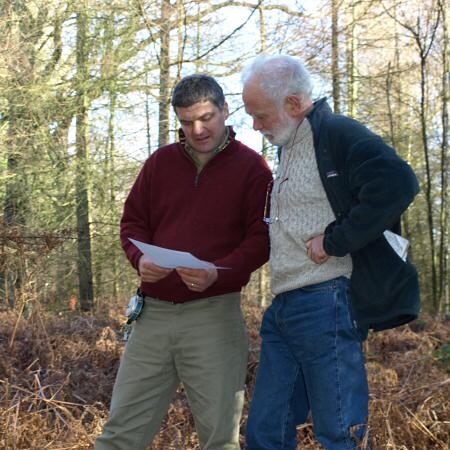
Woodland Management Articles
Practicing Continuous Cover Forestry at Wilderness Wood
by Chris Yarrow - Wilderness Wood

Anne and I had owned Wilderness Wood, a 61 acre mixed woodland at Hadlow Down East Sussex, for seven years when the ’87 Storm blew over or snapped off large swathes of our 27 year old pine plantations. As in most affected woods, other trees also suffered, including oak “standards” in the chestnut coppice, which had leaf-laden crowns snapped apart by the force of the wind. But it was our well-thinned plantations that looked sorriest.
The Storm produced a mountain of small sawlogs, bars,and pulp and we were fortunate to secure outlets before most owners had flooded the market. The logs did degrade somewhat in the period before collection, as there was a severe shortage of transport. Using our own labour to harvest and a salt-of–the-earth contractor to clear the debris we were ready to replant in 87/88. We just about broke even on the work.
The practice of continuous cover silviculture had fascinated me since college visits to the Vosges and we had begun to convert the plantations using the “Bradford-Hutt” system. This involves clearing 6m x 6m plots on an18m grid and planting suitable trees in the space. Six years later one clears another plot on the same side of each first plot, plants more trees, and so on nine times, each cycle thinning the remaining older trees, until an uneven aged wood with the oldest trees of 54 years is produced. At this age commercial species, such as Douglas fir, are suitable for harvesting.
At the time of the storm we had just commenced the second cycle, and found that planting beech and larch was a waste of time. The peaty podsol on the Tunbridge Wells Sand is too infertile for most broadleaves, and the plots too small for light-demanding larch. However, Thuja and Douglas Fir loved it, although the Douglas did better in the lighter locations.
After the Storm, with relatively large areas to replant between scattered groups of pine and beech, we moved up a gear and planted 9m x9m plots of Thuja, Douglas, Beech/Chestnut, and Norway in an 18m grid, all at 2m spacing. Between all trees Norway were planted as a cash crop for Christmas trees, and harvested four to ten years later, recouping most of the replanting cost. The 9m plots were chosen to allow sufficient space for the slower growing broadleaves, and to lessen overshadowing by the Douglas.
So how successful has this complex plan been? The 30,000 visitors we attract each year enjoy visually varied stands. Wildlife, including deer, foxes, badgers, and owls, benefit from the richer habitats, and there is a much more flexible system to respond to what climate change may throw at it.
The unfashionable non-natives are already being profitably thinned for tepee and rustic poles, and will provide large volumes of high quality sawlogs in due course. The better trees are high-pruned, with foliage sold at Christmas. As a guide to site suitability, top heights of Douglas and Thuja are 16m and 15m respectively, putting them off the top ends of the yield class tables. For us, the silviculture is a far more enjoyable challenge than any conventional system could produce.
Chris Yarrow, Wilderness Wood
enquiries@wildernesswood.co.uk
www.wildernesswood.co.uk